|
3 JULY 2002 |
|
|
|
Scarcity of land and high rises The recent suggestion by a renowned construction company for the building of a residential/commercial high rise in Qawra has irked a number of the locality’s residents and has brought the hitherto relatively unexplored planning concept to the fore. No one could deny that the country is rapidly approaching a saturation point at which a scarcity of land avaliable for development will soon become evident and many, in fact, are urging the authorities to look closer at this particular solution to Malta’s land deficiency. The scarce amount of land available for new investment, in the tourism sector especially, has prompted some architects to question whether it wouldn’t be better to allow controlled high-rise developments in certain areas of the island – particularly in the more tourism-oriented locations. The mere mention of the prospect of a high-rise development tends to result in vehement protests among the critics, especially environmentalists, who inevitably raise the argument that Malta’s vacant housing stock should be utilised before taking the ‘high road’. Of course, it is undeniable that remedial action needs to be taken to seriously address the amount of vacant stock on the islands and any such action would be warmly welcomed by many in the business community. But while we await news in this respect, which has been a long time coming, one must also look at the possibility of whether a valid answer lies in building higher in certain areas. However, it must be emphasised that any such development must be controlled and must not be located in places in areas of historical value. Allowing for high-rise developments is not necessarily the answer to the problem of land scarcity and the concept of raising building height levels in order to allow for further investment holds its inherent implications, mostly in that it would mean further intensification in existing tourist areas. Such intensification would increase the load on the infrastructure – in terms of electricity, water, sewage and traffic - and for an area’s social fabric, as the residents of Qawra have pointed out. These considerations, coupled with a visual impairment for the residents of a proposed high-rise area, could deter the quality of life in the area. The Qawra Development Brief itself serves as an example of development that diversifies the tourist product without compromising the environment and it remains to be seen whether the Planning Authority is to include the proposed Qawra high-rise within the remit of the Brief. The current Structure Plan for the Maltese Islands, while guiding the Planning Authority, encourages the development of tourism accommodation within the built-up areas of the main tourist localities - such as the tourist laden Qawra. However, each and every case must be weighed on its own merits. Building higher is certainly one of the options at hand but there could be other potential solutions as well. Many times there is no single solution, and when it comes to high rises, there can be no blanket policy - each case must be taken into consideration on its own merits.
|
|||||||||
Copyright © Network Publications Malta.
Editor: Saviour Balzan
The Business Times, Network House, Vjal ir-Rihan San Gwann SGN 07, Malta
Tel: (356) 21382741-3, 21382745-6 | Fax: (356) 21385075 | e-mail: [email protected]
